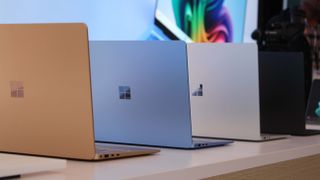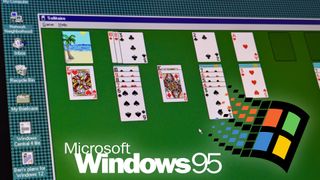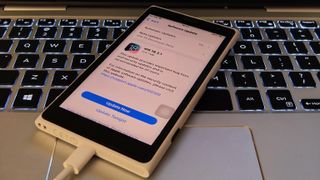When you cover tech news for over a decade, you notice news often comes in bunches. This past week, the collective tech world must have been feeling a bit nostalgic, because Windows Phone and Windows 95 were both in the headlines. We also saw the Halo TV series potentially get a second life through Netflix. And while not necessarily good news, our Senior Editor Zac Bowden broke down how Microsoft’s Surface lineup has changed over the years.
Surface is dead… kind of
The Surface brand is not quite dead, but it’s far from what it used to be. As we now sit 18 months from the departure of Panos Panay, Microsoft has shown its new path for the Surface brand. Gone are the days of innovative form factors that may not be commercial successes.
“Unfortunately, that means the more extravagant Surface hardware of yesteryear no longer has a place in today’s Surface portfolio. Devices like the Surface Studio and Surface Duo that appealed to niche markets have been given the boot, and the focus is now entirely on hardware that resonates with business customers and wider markets,” said Bowden in an editorial this week.
Boring isn’t exactly bad, it’s just… not exciting. Microsoft still innovates in the PC space, but in ways such as using NPUs and integrating AI.
Luckily, those who love PCs that push boundaries can look Lenovo’s way.
Halo TV show on Netflix
The Halo TV series did not receive the critical acclaim and viewership of Fallout. Those two shows are both based on Microsoft-owned video game franchises. While Fallout is getting a second season, Halo is hoping to get a second life.
The Halo TV show was a Paramount+ exclusive, which our Richard Devine compared to “Metallica playing their only show of the year in Greenland.” You need viewers to keep a show going, and it doesn’t seem Paramount+ is the right platform for Halo.
Soon, the Halo TV show will be available on Netflix in several regions. Could that lead to a third season for the canceled Halo? Perhaps. But at minimum it will make the show more accessible.
Windows 95
Windows 95’s setup process was the virtual equivalent of three men in a trench coat. Upgrading to the operating system presented unique challenges for Microsoft over three decades ago, and the company’s developers had to decide the best way to present the experience to users.
Raymond Chen, who has worked on Windows for over 30 years, shared a blog post last November that explained why the Windows 95 setup process used three operating systems.
The problem Microsoft had to solve was that people could upgrade to Windows 95 from MS-DOS, Windows 3.1, or Windows 95 (this last option was for repairing corrupted systems). One solution would be to use a text-based setup program that would work on all three operating systems, but that would not have been the best experience. The tech giant also could have made people install Windows 95 before setting it up, which would look better but was not an ideal solution either.
The final decision was to find a middle ground, as explained by Chen:
“In the middle is the happy medium: You can have the MS-DOS setup program install a minimal version of Windows 3.1, just barely enough to support what the 16-bit GUI setup program needs. This tiny version is small enough to be copied and installed off a small number of floppy disks. Once that’s done, boot into the tiny version of Windows 3.1 and run the 16-bit GUI setup program.”
In a follow up to that post, Chen answered questions about why Microsoft did not just use graphics in the MS-DOS setup program. The long-in-short is that MS-DOS technically could have done graphics, but it would have required quite a bit of extra work.
“So now you’re going to write all this code for your setup program, none of which is actually involved in setting up Windows 95, but is just the infrastructure needed to run the setup program at all! There’s a lot of stuff here, and you probably won’t be able to cram all of it into 640KB of memory,” said Chen.
“So now you need to write a protected mode manager (also known as an MS-DOS extender) so you can take advantage of the larger address space afforded by protected mode.”
Taking that approach would have essentially required Microsoft to make another operating system that was solely for the purpose of setting up Windows 95. With that context, it makes sense why Microsoft decided to go with a different approach.
Windows Phone revived?
Despite Windows Phone dying years ago, we look for any excuse to cover the operating system here. So, when I saw headlines about a Lumia being revived as a modern device, I got excited. No, those stories were not about the HMD Skyline. Instead, they focused on a project that saw the parts of an iPhone SE (Gen 3) placed inside the body of a Lumia 1020.
Reddit user OceanDepth95028 made the device and dubbed it the “NokiApple LumiPhone 1020 SE.” Since the phone is made with genuine iPhone parts, it is (almost) fully functional. Apple Pay and wireless charging do not work but the device runs the latest version of iOS and receives OTA updates.
It’s rare to find Windows Phone fans in 2025. In fact, Windows Phone fans were even hard to come by when the OS was in its hay day. Daniel Vávra of Warhorse Studios fame said people at Microsoft headquarters were “shocked” when they saw Vávra use a Windows Phone.
Don’t worry Vávra, you were not alone. Many of us at Windows Central rocked Windows Phones back in the day.
Windows Central Podcast
Each week our Editor-in-Chief Daniel Rubino and Senior Editor Zac Bowden run through the biggest topics of the week. They also provide insight into industry trends and sometimes share exclusive information, so it’s worth tuning in live. If you can’t catch the show live, you can always catch up afterward through YouTube or your favorite podcast platform.
In the most recent episode, Bowden and Rubino discussed how the Surface brand has changed over the years as well as this week’s biggest news.
Reviews
Our experts go hands-on with the latest gadgets, games, and more each week. Our latest reviews take a closer look at “Like a Dragon: Pirate Yakuza” and the refreshed Zenbook Duo. We’ve published a ton of reviews this month, so I’ve also included all of the most recent reviews.
The Zenbook Duo is the star of this week. It runs on an Intel Core Ultra “Arrow Lake” H-Series chip and has a pair of 3K OLED screens. That’s not a typo, the PC has two screens, and they aren’t little screens or an action bar.
The screens of the Zenbook Duo can be used in a variety of postures. The laptop has a built-in kickstand to improve its versatility.
While the Zenbook Duo stands out at first glance due to its screen, it’s more than a unique form factor. The laptop earned perfect scores for its value, display, battery life, keyboard, and touchpad.
Our Cale Hunt concluded his review by saying:
“Like the first Zenbook Duo (UX8406), the 2025 model is just plain fun to use. I have more ideas on how best to use this clever screen combination every few minutes, and so far, it’s worked brilliantly on almost every occasion. If it’s within your budget, you won’t regret picking up this triumphant 2025 revision of the Zenbook Duo.”








